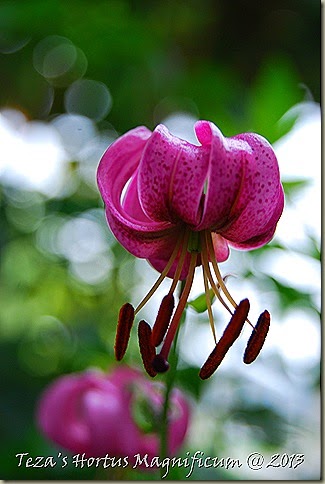When your garden is cast predominantly in shade, you learn rather quickly that the focus of your efforts shifts from floral to foliage displays, and what better way to maintain this new philosophy than by incorporating a few 'go big or go home' specimens along the way!
It was during my tenure at Lost Horizons nursery that I was first introduced to the magnificence that is Diphylleia cymosa. Native to the Appalachian mountains, American Indians used this plant medicinally, and more recently it has been touted as a potential anticancer agent.
It's striking, tropical looking large palmate shaped foliage usually appears in pairs per each stem, and are remotely similar in appearance to Podophyllum when first emerging in the Spring. Insignificant small whitish flowers are carried in small clusters above the foliage. As the season progresses the fading flowers are replaced with startling blue fruit, carried on long ruby infused petioles! This in and of itself warrants including this wonderful plant in your shady repertoire!
Leafstalks are somewhat reddish, 60-95cm in height with the palmate foliage growing to am amazing 60cm across! These leaves are a medium green, deeply cleft along the centre line, each half with 5-7 smaller, coarsely toothed lobes.
Typically the genus is restricted to cool mountainous regions [Zone 5-9] and is said to resent excessive heat and humidity. It should also be assigned a protected, sheltered placement to avoid strong winds and potential storm damage to its magnificently large foliage! A note of caution: Beware slugs and snails! Newly emerging growth as well as exposed rhizomes are under constant threat to these pernicious garden pests!
![DSC_0551[1] DSC_0551[1]](https://blogger.googleusercontent.com/img/b/R29vZ2xl/AVvXsEgVR6ArpEG-ZS8TCsodrYw3887UmMuShMCytRFo2In-gMG_E9ufYEWuWlndKW8hbfJUElTYs7w6znP0V9MzQEUTx-v0qfSSB2nTkgyS2h16AAdjbIh332eAnh6lf81eOaE1s0Hwz63cZ0E3/?imgmax=800)
![DSC_0057[1] DSC_0057[1]](https://blogger.googleusercontent.com/img/b/R29vZ2xl/AVvXsEhkajaBHTZLG7VgN_XVWBjeyfsgtaXxdELumHSz06Mq-Mhtpo0TJMUgyfEOptELznxUBkHMbk1Z9arhBH7ew0kF6KSYHUljtFRax9wJk13powRUqvzLBVb7fO5U8OCTX8sL6tebVajL2AvF/?imgmax=800)


































2 comments:
I can't believe that this plant isn't more well known.
I had a number of visitors from OR&HPS this Summer and despite the fact that they are all very accomplished gardeners, no one recognized D. cymosa.
I made sure to collect seed for the OR&HPS seed exchange this Fall.
Barry P:
Like you, I am forever stunned to realize that, while a North American native, few, if any gardeners that visit my tiny plot are able to recognize Diphylleia either! Of course this doesn't stop them from begging for a division or as you mention seed. I guess if we start off slowly, each in his own garden, we might be able to bring it at least a modicum of exposure! PS: Had a sneak peak at your profile in GardenMaking via the local library copy. I shall seek a copy of my own this week! Wonderful write up. You present the plant hoarder's case very eloquently!
Post a Comment